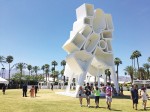Jimenez Lai had to crane his neck the first time he saw his 52-foot-tall art installation. He felt a sudden rush of emotion – he hadn’t seen how his work would look in real life until it was installed in a grassy field at this year’s Coachella Valley Music and Arts Festival.
“I think I wanted to lie down, roll around and cry a little,” said Lai, a UCLA architecture and urban design lecturer.
Lai’s installation, “The Tower of Twelve Stories,” was on display during Coachella. The model’s white cartoon bubbles, piled haphazardly on top of each other, towered over festivalgoers, stages and performers and joined the La Grande Wheel as a part of the Indio, California, skyline.
Lai and his architecture and design firm, Bureau Spectacular, were approached by Goldenvoice, the company that produces Coachella, to create the installation. The team then began to brainstorm and write a proposal on the first large-scale design Lai had ever done, based on his long-held interest in skyscrapers.
For Lai, skyscrapers adapt to whatever occupies them. The shapes and forms that make up the skyscrapers repeat over and over to add flexibility and strength to the structure, a concept Lai said he had been interested in exploring.
The cartoon bubbles were the repeated forms in “The Tower of Twelve Stories.” Lai and his team originally tried to think of stories to match the personalities of the bubbles. However, they eventually scrapped the idea, instead leaving the interpretation of the installation to the crowds of festivalgoers.
For some Coachella attendees, the model, which lit up at night, held individual meaning. Festivalgoer Alec Parkinson thought the misshapen cartoon bubbles represented hot tubs and swimming pools in Palm Springs, California, that people could play around in.
“People are literally just coming out to Palm Springs (in the installation) to jump from one hot tub to the next hot tub to the next hot tub,” Parkinson said.
Parkinson, who had been taking a picture with a woman in front of the tower, was one of many who hung around the tower either to wait for friends or to escape the heat in its oblong shadow. Lai said one of the main concerns in constructing the model was to provide shade, since temperatures in Indio reached above 90 degrees over Weekend 2.
Wind flow was also a concern for the design team, since Lai did not want the four-story-tall model to fall over during the festival. A team of engineers had to place the model in a wind tunnel to check if it would be stable in gusty, 20 mph wind speeds.
The tower proved stable: Its steel endoskeleton held it together, while 40 screws anchored it to the ground.
Coachella attendee Julie Christine Chong said the tower was a distinctive landmark that other attendees definitely noticed. When looking at the tower, Chong interpreted the installation as her experiences falling into place at the end of the day.
Lai said he still cannot believe his model is at Coachella, since some of his favorite musicians and artists could have seen it while walking through the Coachella grounds. He said he would not hesitate to build a similar model for an event like Coachella in the future.
“I’m just happy that James Murphy from LCD Soundsystem and Ice Cube probably have seen it,” Lai said.
Though Lai said “The Tower of Twelve Stories” was an installation with a meaning to be interpreted by viewers, Coachella attendee Jessa Parkinson saw it simply as art for art’s sake that reflects each viewer’s inner thoughts and emotions.
“It’s just a piece of beauty, and it is all about what each person feels,” Jessa Parkinson said.
